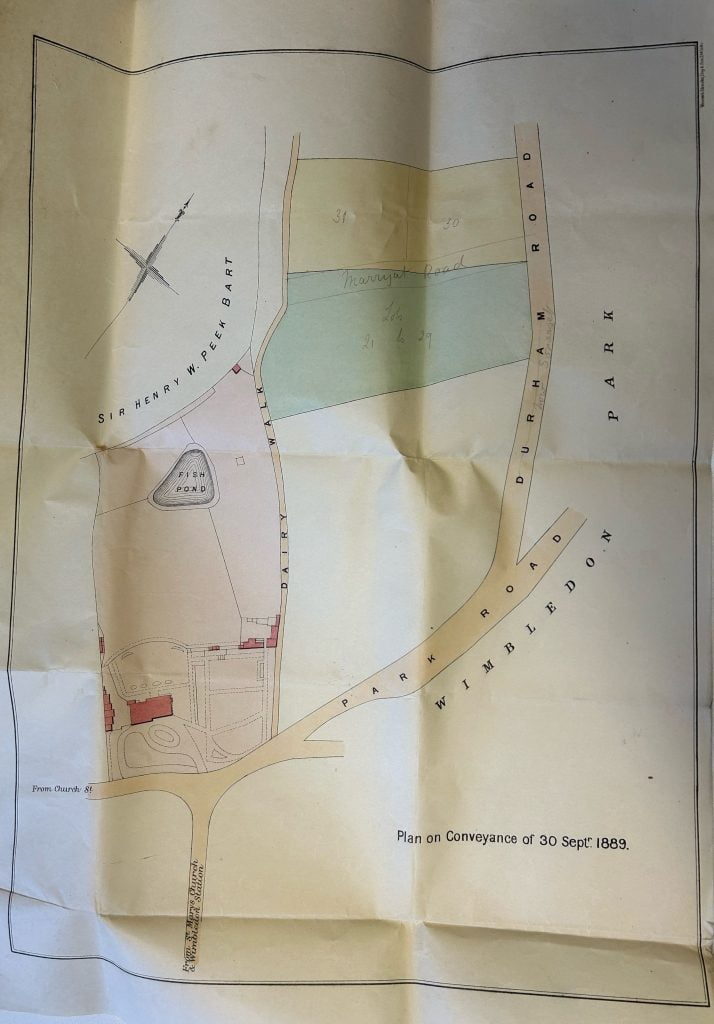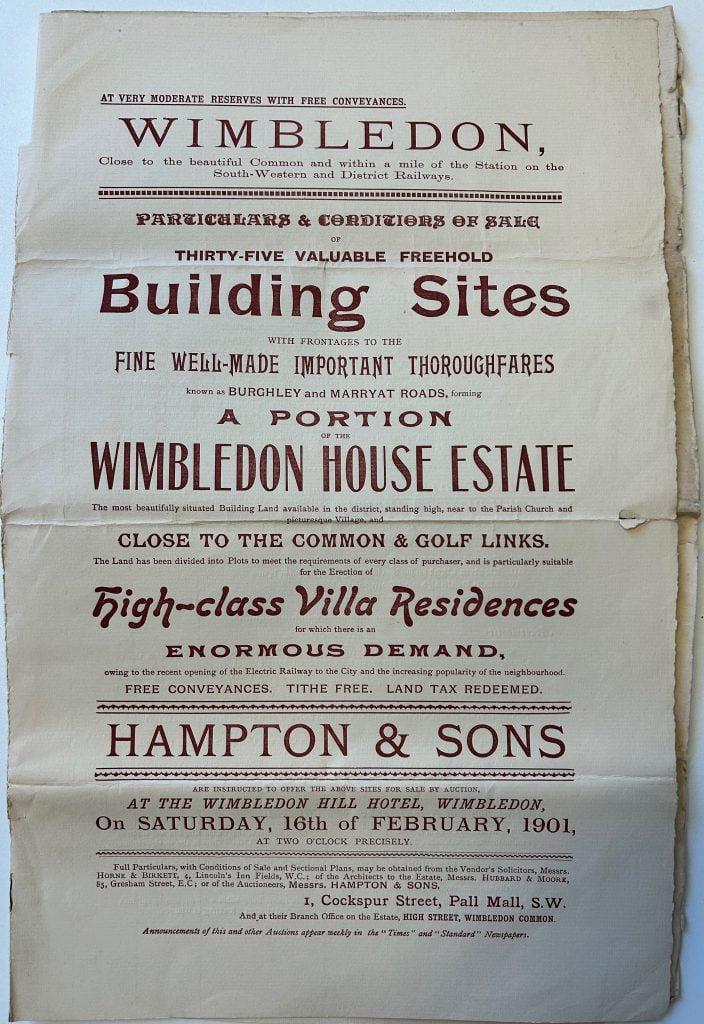
Wimbledon House Estate
This series of blogs in our From The Archives series is intended as a resource for schools and local residents who are interested in researching local history.We are very happy to help schools with access to relevant materials. However, the images that are reproduced here should be assumed to be the copyright and may not be reproduced without license from the archives and commercial use is therefore strictly prohibited.
This blog owes special thanks to John Keeble, Director of Hamptons, Wimbledon without whom this would not have been possible.
Manorial History
The manorial history the Wimbledon Park Estate is very well documented by a number of sources. The earliest reliable source is The Environs of London: Volume 1, County of Surrey Pubished by T. Cadell and W. Davies, London, 1792 in which Wimbledon features in pages 519-540.
A trap for unwary is that the names Wimbldeon House, Belvedere House and Wimbledon Manor are used interchangeably and confusingly in a number of sources for a number of different properties.
A further wrinkle is that all three were, for a shot period of time, under the common ownership of Sir Theodore Janssen.
Janssen was heavily involved in the South Sea Bubble and lost most of his assets. This is gone into in great detail in a book entitles “The Case of Sir Theodore Janssen, One of the Late Directors of the South-Sea Company.” However, he managed to buy back The Wimbledon House Estate and possibly the Belvedere House Estate. We can only be certain of which deeds relate to which house based on deed plans & maps. With a lot of historical deeds the plans are not drawn on the deed or firmly attached but folded into the deed and over the intervening 300 years the plans have progressively detached themselves and then separated themselves from the deeds.
Through various owners
Wimbledon Museum, formerly the John Evelyn Society, hold a very good run of the original deeds [catalogued as boxes A4.83 1-10, 11-18 & 19-26] for the Wimbledon House Estate from 1711 through to 1820 tracing the house and lands through the hands of Sir Theodore Janssen (19th July 1717), Sir Henry Banks (4th August 1756), Sir Robert Brompton (12th June 1776), Earl Gower (4th October 1792) there is curiously a Mr Sheppard [spelt Sheepheard but spellings, of names are generally unreliable, as they are quite phonetic] involved in the sequence and we are researching if that ties in with our investigations into the Toast Rack and Magdalen Estate, Sir Stephen Lushington (22nd June 1798), Samuel Marryat (6th November 1817), Joseph Marryat (7th November 1817), Captain Marryat (29th February 1820).¹
The Marquis of Rockingham’s habitation of Wimbledon Park Estate , leased/rented the house from Samuel Rush and Elspeth Veale published a study on this in the Georgian Group Journal, Vol XIV, 2004, pp. 243-260.
12th February 1846 Earl Spencer sold his Wimbledon lands, part of which became part of the Wimbledon House Estate, to John Augustus Beaumont for £80,000.
Sir Henry William Peake Bart assembles the lands which became the Wimbledon Park Estate
11th August 1857 Joseph Marryat’s executors Wimbledon House to Sir Henry William Peake Bart.
This may have been as a result of the auction held on Friday 3rd July 1857 at The Auction Mart opposite the Bank of England or may have been by private treaty.
Wimbledon House Estate plan from the 3rd July 1857 auction catalogue by Rushworth and Jarvis. By kind permission of Northamptonshire Archives Service SOX140. Click the image to see the full catalogue as a PDF.
21st November 1883(?) John Augustus Beaumont sells Dairy Farm to Sir Henry William Peake Bart to enlarge the Wimbledon House Estate.
30th September 1889 Sir Henry William Peake Bart further enlarges his land with an acquisition. The deed map/plan below shows the exact areas the deed covers. Interestingly the plan is printed by the exact same printers on the exact same paper as used by the Wimbledon Park Estate Company in the 1879 map of the estate.
Sir Henry Peek’s acquisition of lands to add to the Wimbledon Park Estate from an extract of the 30th September 1889 deeds prepared for the Wimbledon House Estate Ltd – Courtesy of Hamptons – The original is in the Surrey History Centre K160/3. Click the image to see the full copy deed as a PDF.
26th August 1898 Sir Henry William Peake Bart dies.
26th April 1899 Sir Cuthebert Peake sells the lands that make up the Wimbledon House Estate for £160,000 [Wimbledon Museum A.4.40 Accession number A569].
The Wimbledon House Estate Company
The Wimbledon House Estate Company Ltd was setup by the Barclay Brewing dynasty. The Barclay Brewing holdings then later became part of Courage Barclay and Symonds Ltd which eventually was simplified to Courage Ltd in 1970.
The timeline of the Wimbledon House Estate development, was sandwiched between and intertwined with that of the Wimbledon Park Estate and also its near neighbour the Belvedere House Estate. Some land was also sold to The Eagle House Estate for development by Thomas Graham Jackson who was a renowned architect and lived at Eagle House.
The History of The Wimbledon House Estate Company Ltd is inextricably linked with that of Hamptons. Hamptons still occupy their original site offices on the corner of Marryat Road and Parkside and they have a considerable archive of materials that have been retained from the early days of The Estate.
But above all the story of Hamptons and The Wimbledon House Estate Company Ltd is one of a sound business relationship, trust and empowerment.
Reading through the files is an amazing insight into the early days of professional estate agency. The thing that shines through is how professional and polite everyone in inspire of some rather interesting behaviours!
We have reassembled and reordered the files as best we can. There has been a fair amount of inference and a little guesswork in the process. A lot of the papers were simply bundled in no obvious order. We left the physical files as they were and rearranged the pages in the digital domain. Maybe eagle eyed readers will realise we have got something wrong! We may well have done: we would be interested to hear your views.
Hamptons appointed as sole agents April 1899
Hamptons were appointed as sole agents for The Wimbledon House Estate Company Ltd by an agreement dated 24th April 1899.
Agency Arrangement between Messrs Hampton and Sons Limited and The Wimbledon House Estate Company Ltd dated 24th November 1899 – Courtesy of Hamptons
The key terms of the agreement may be briefly summarised as Hamptons:-
1] were to become shareholders – so it is a true collaboration of equals; and
2] would set up an office on Parkside and have the option to purchase the site at the sum of £3,500 to be exercised within three years of the date of the agreement; and
3] were appointed the sole agents; and
4] were entitled them to a 1% commission on all sales or 2/5ths of a years ground rent on plots leased; and
5] would reduce their fee by 1/4 in the case of Hamptons not being the introducer; and
6] would equally division of commission with another introducer unless there was already communication with Hamptons; and
7] commission covers all costs and disbursements; and
8] to finish valuations if the Directors so require at their usual charges to be agreed in advance; and
9] name to be added to all advertising and paperwork; and
10] to give a free advertisement in bold type in their monthly sales list said to have a circulation of one thousand copies per month etc.
How to subdivide The Wimbledon House Estate?
As with any property project there are various schemes mulled over. One fascinating survival is this undated map from prior to 1901 which shows Burghley Road as proposed road. If you look closely this even has drawing pin marks on it suggesting that it was up on the wall somewhere in the office. It is fascinating to think that this might have been pinned up in the same building where it is stored!
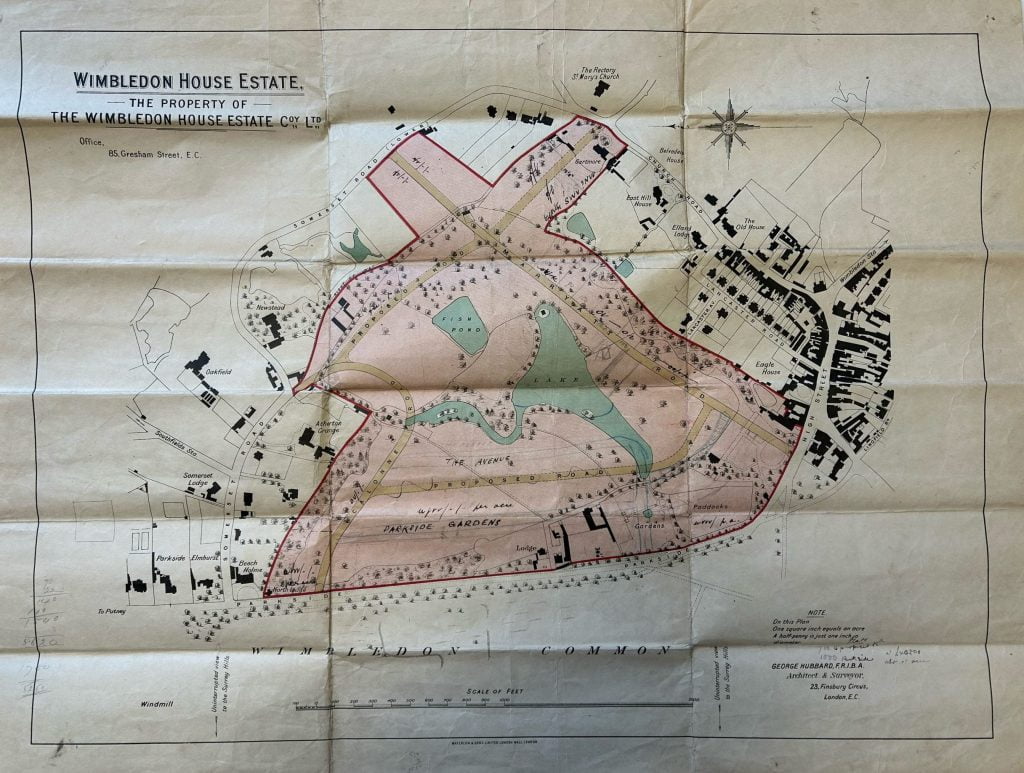
One thing that is striking, at a causal glance at this map and the 1879 map of the Wimbledon Park Estate is the similarity of shape and orientation of the Earl Spencer Lake in Wimbledon Park and the Wimbldeon House Estate main lake.
This early plan is very interesting both from the point of view of showing what might have been envisaged in the first place and what then actually was created but it tells us who the master planner actually was. George Hubbard FRIBA, family website here and other link here, was a well known architect of the time. There is a clear link between him and the Barclay brewing family as well. He was twice Vice-President of the Royal Institute of British Architects.
Hubbard was clearly the master planner of the estate as well as being the architect of a number of quite a number of homes. He was, in his own right, a very prestigious architect of the era.
Looking at the printing, paper and colouration of the map it struck us that this was very similar in composition to a bank note of the period. After a little bit of digging it turned out that the printers Waterlow & Sons were indeed banknote printers and were subsumed into what became De La Rue.
Another survival is this strange fragment is this cut out of a partial plan that is annotated on the rear. We cannot quite make sense of this. Can you? We would be very interested in hearing your theories!
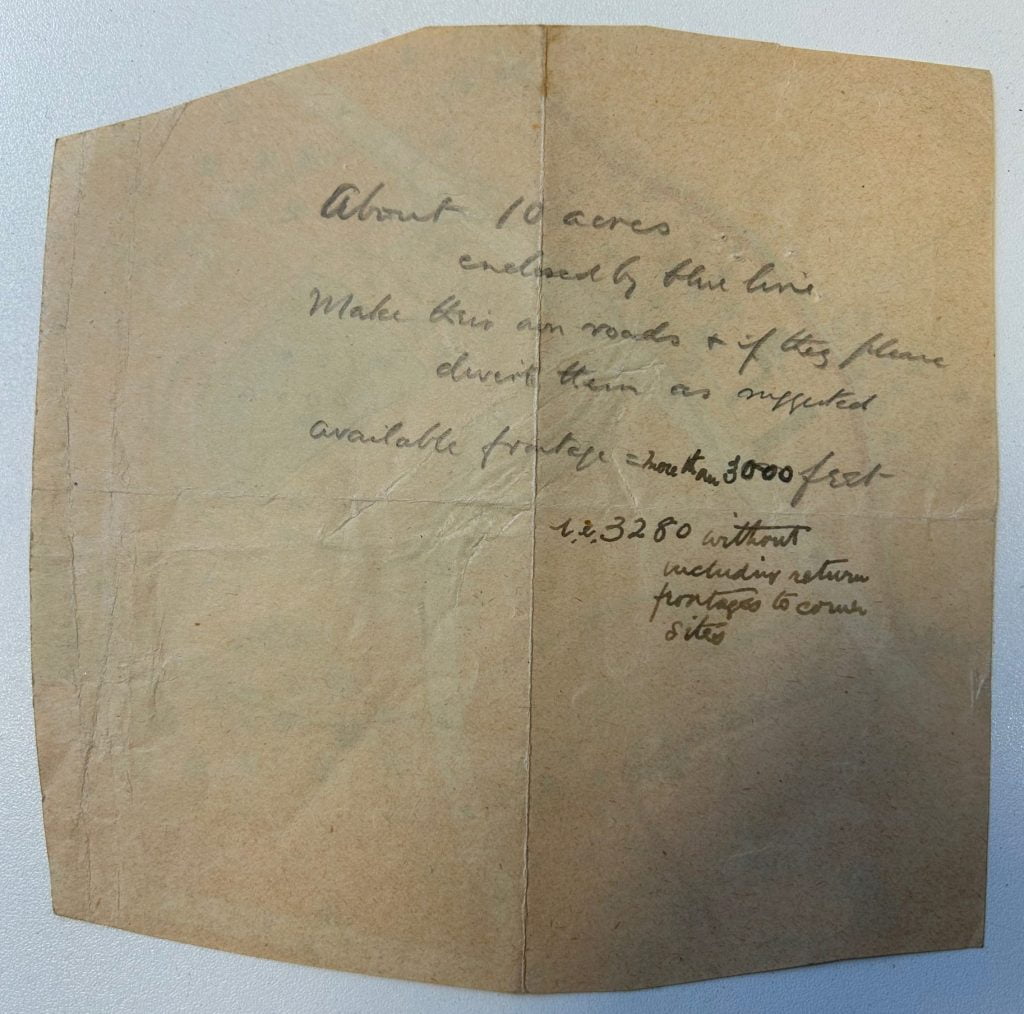
Filling in ponds and the limbs of the lake – April 1900
The ponds and limbs of the lake were progressively filled in to create more building lands.
Entrusted to discount – May 1900
Hamptons were entrusted to discount the advertised prices by up to 20% at their discretion by way of this letter, dated 29th May 1900, setting out a decision of the board of directors of WHEC. This shows a very high level of both trust and pragmatism in the commercial relationship between The Directors of The Wimbledon House Estate Company and Hamptons.

First auction – February 1901
An auction for 35 freehold building plots. We have a partial copy of the auction catalogue with the pages for lots 18-32 was missing in Hamptons copy as was the map. We have found another partial copy with different pages missing and reconstructed the catalogue digitally. The folding pattern of the catalogue is consistent across all three partial copies which we have found. [updated catalogue with the fully digitally reconstructed version coming soon].
16th February 1901 – auction catalogue for the Wimbledon House Estate – auction held at the Wimbledon Hill Hotel at two o’clock precisely – Courtesy of Hamptons in part and others. Click here to open the full auction catalogue as a PDF.
The 1901 auction plan from a partial surviving catalogue.
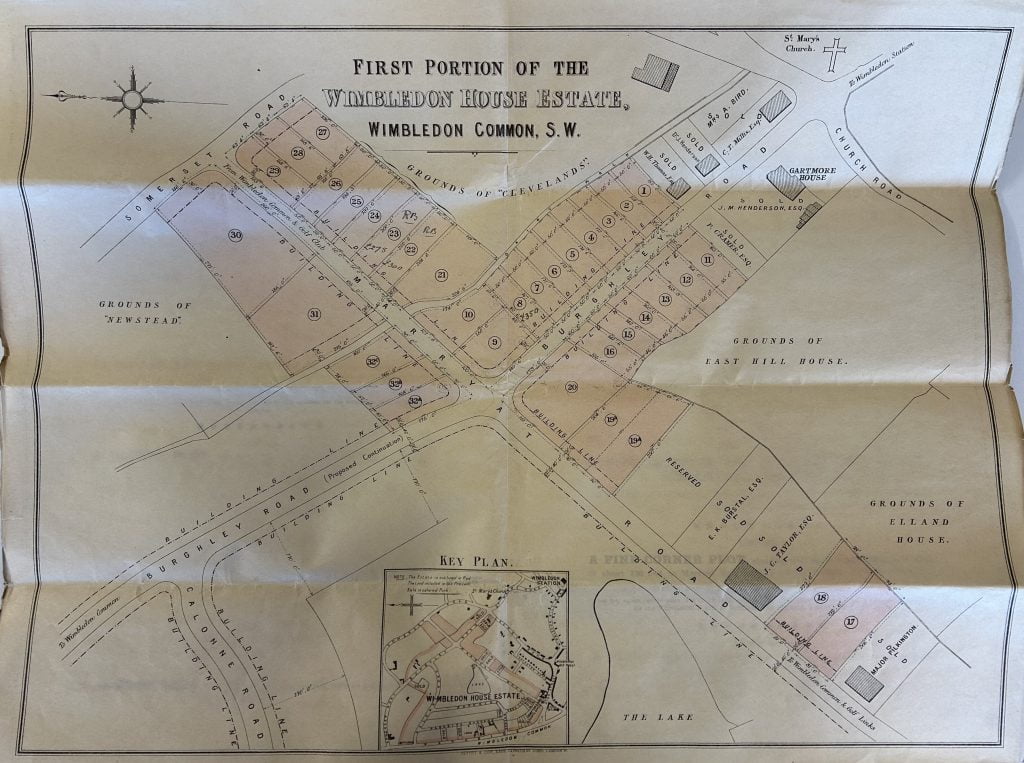
It is likely that we also have the auctioneers notes as the notes mention ‘around 30 plots’ and the way the plots are numbered there are 32 plots offered with plot 32 being subdivided to 32a/b/c. Hence the 35 plots stated on the inside over of the catalogue. So the numbering of the plots in the auctioneer’s notes and in the catalogue is exactly the same. However, whilst this is likely, this is only a reasonable conjecture based on the partial material that has survived.

We do also have the calculation for the payout from the 1901 auction and covering letter for the cheque – clearly things are going very well from the upbeat tone of the letter.
The value of the sales at the auction is not spectacular at £7,681 and maybe this a harbinger of what comes next?
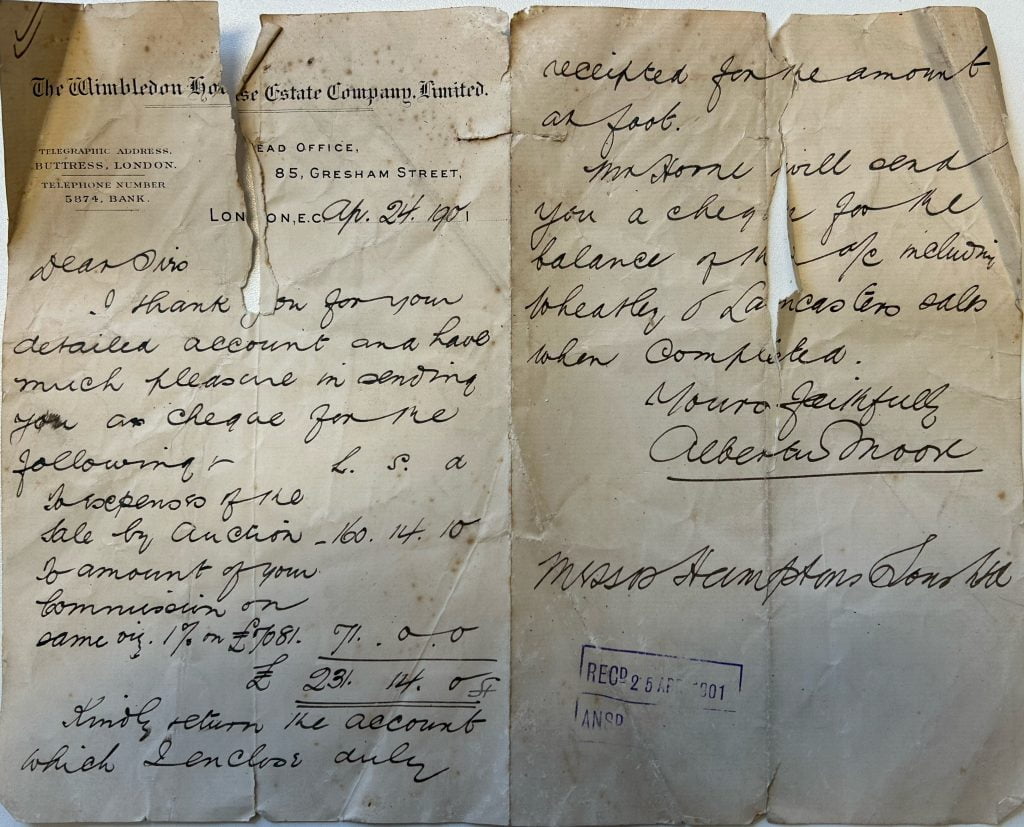
Change of shareholdings – August 1902
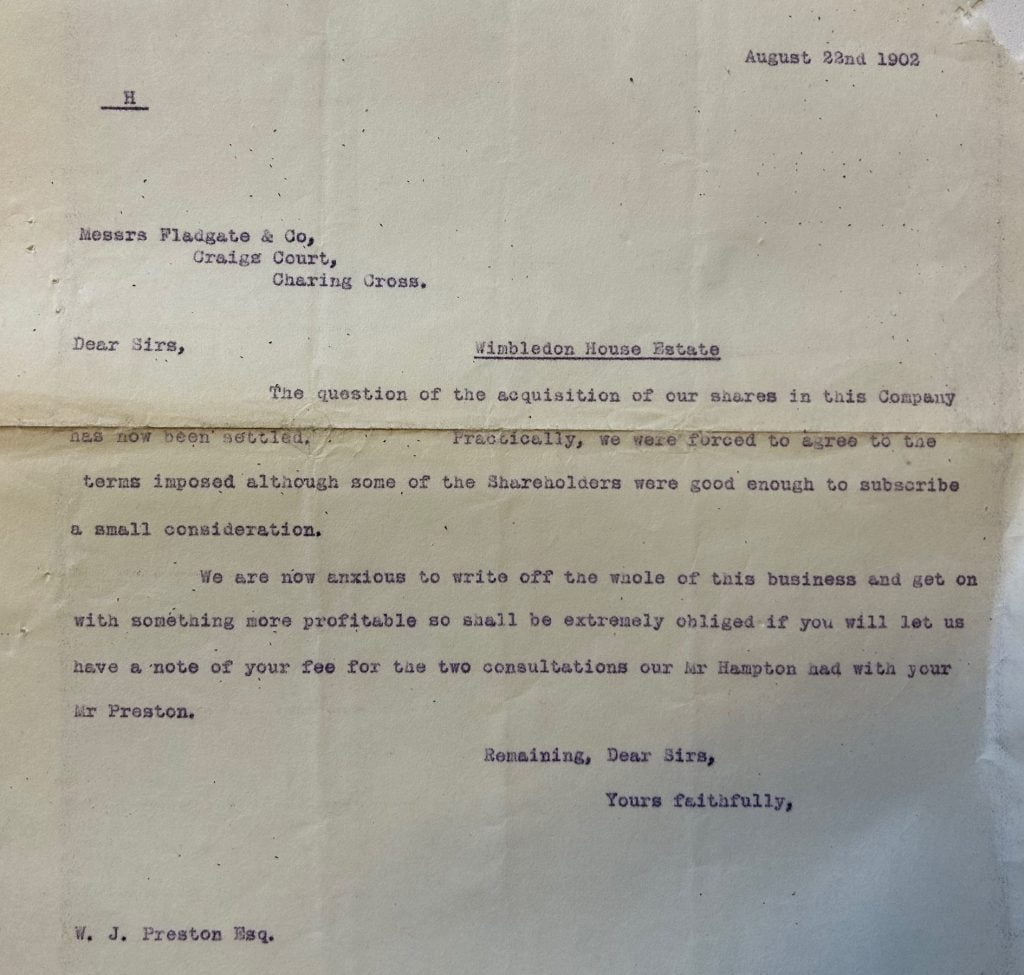
Hamptons set out to buy their site
Hamptons set out to buy their site in 1902, with a little help for an inept solicitor, who fails to forward a cheque. An inept conveyancing solicitor: does that sound at all familiar to anyone involved in property?

This crystallised in the correspondence early in 1902 which sealed the transaction and so Hamptons have their second permanent location.
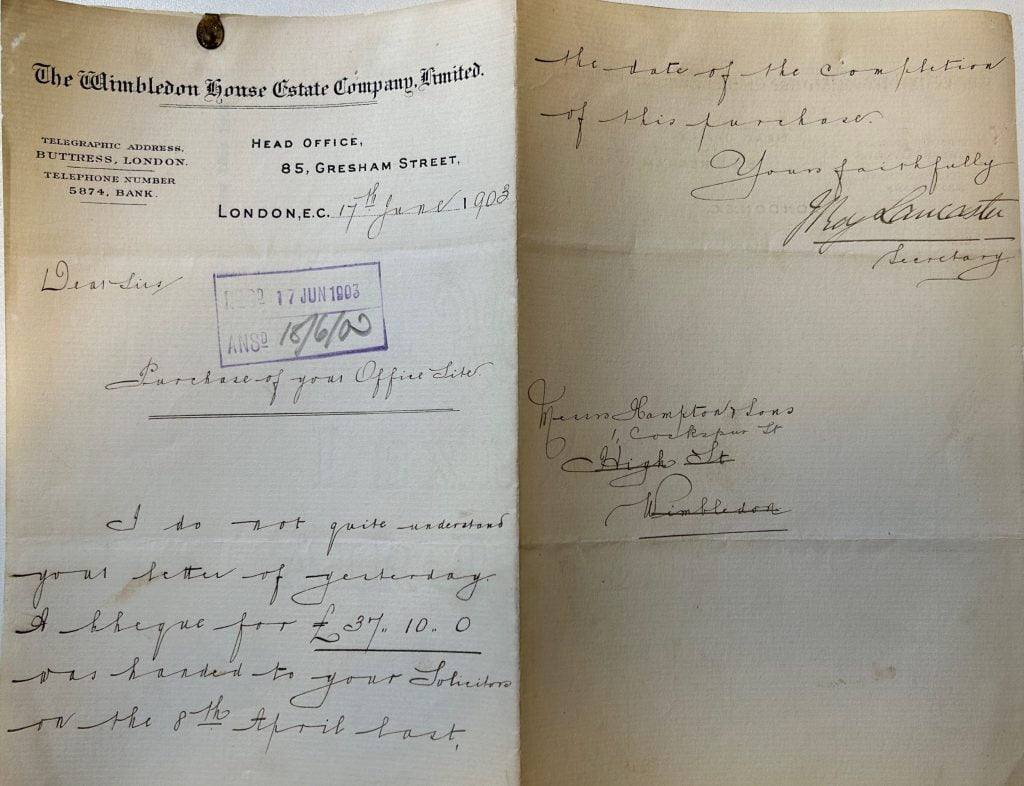
After some slightly puzzling correspondence running between 1902 and 1903 – there is clearly another matter in play here and that is possibly the alteration in the shareholding agreement.
It is very plausible that the office site proposal was in partial place of a cash payment as that would explain the rather small final cheque that was, in effect, a balancing payment and not the principle. There is, however, no evidence for this conjecture.
We have included some jottings on a small piece of card that appear to be notes of a conversation or telephone call regarding the covenant negotiations for the office.
Second Auction – 1906
We have extensive documentation on the production of the auction catalogue, including an estimate from Pettitt and Cox below for £13 12s 6d for 400 copies of the catalogue and £8 12s 6d for 400 copies of the colour map.
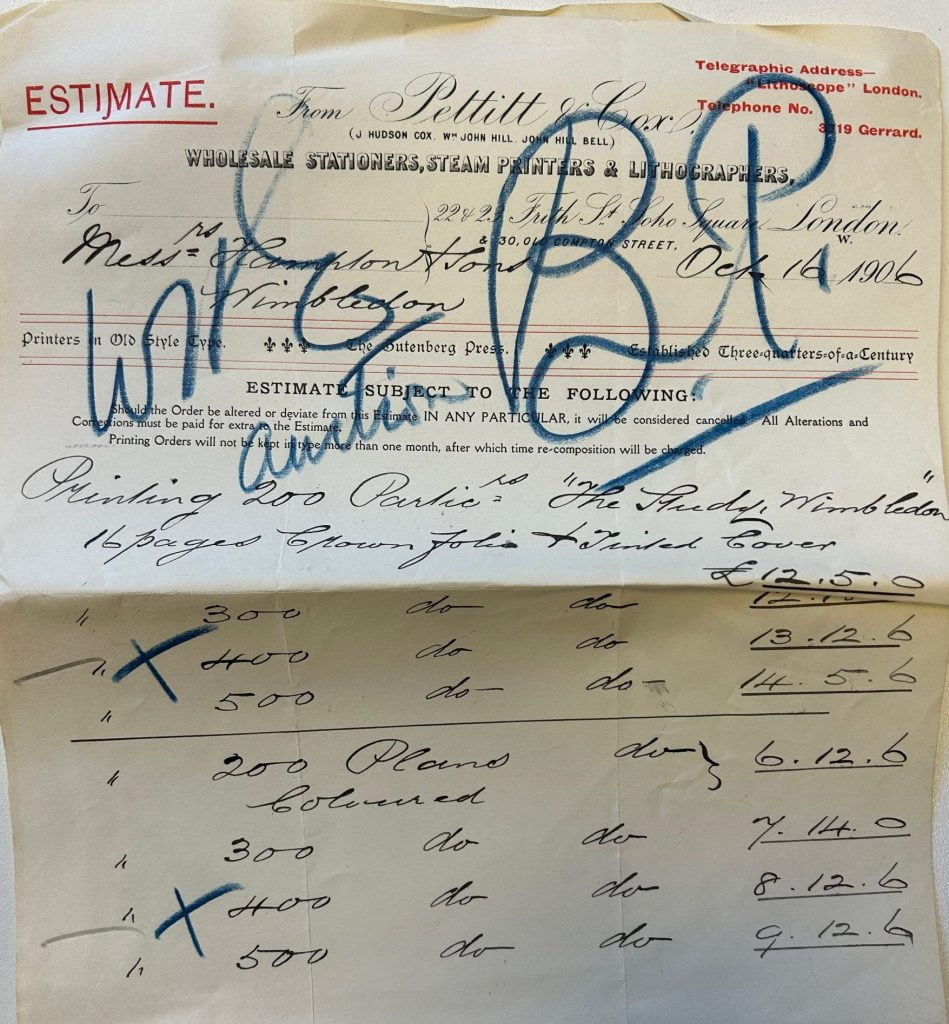
There are also have a considerable number requests for the catalogues and/or the map/plan.
Sadly we appear to neither have the catalogue or the plan for this auction. We are continuing to search for it.
However, we do have a deed plan dated 1906 with plots marked and numbered on it. It is highly unlikely that such a plan would be printed for the sole purpose of the deed so it is reasonable to assume that this has been extracted form the 1906 auction catalogue.
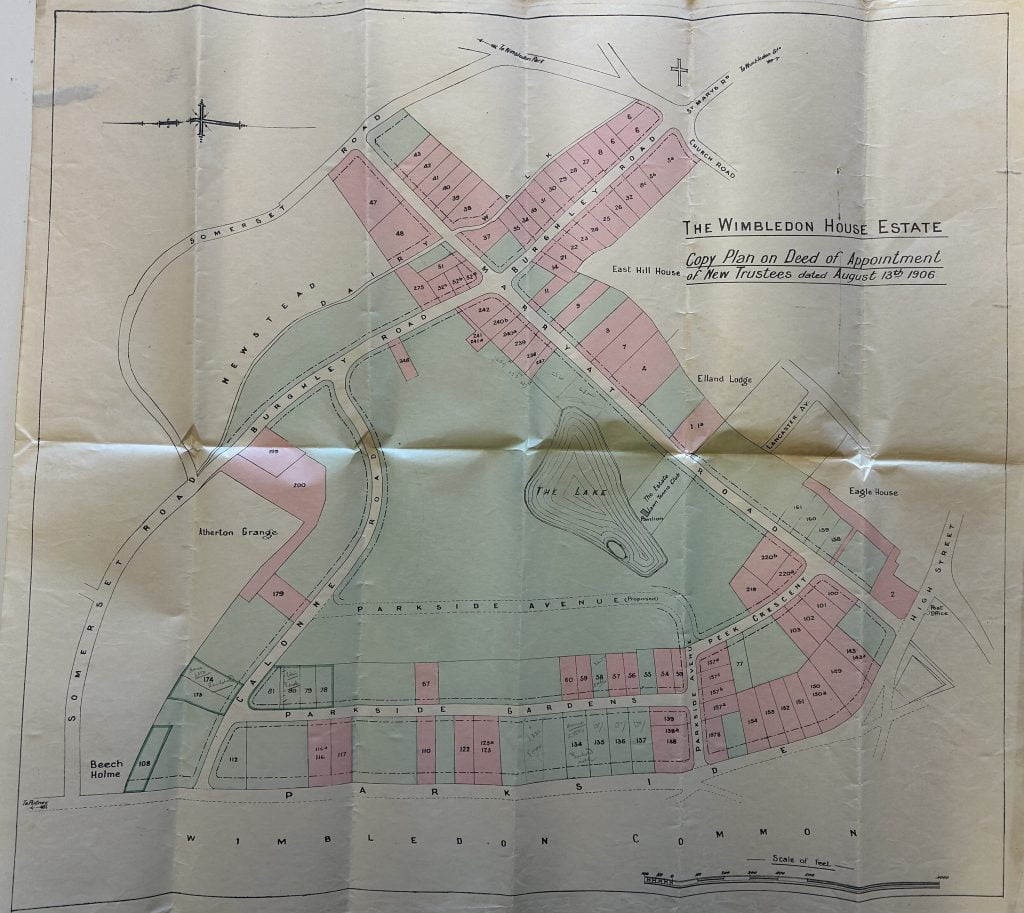
In the papers which we have there is a set of undated and untitled auctioneers notes that we have there is a discussion of the sale of the freehold of a building called “The Study” Peek Crescent Wimbledon Common. This is presumably The Study Prep School Wimbledon’s, Spencer House site which is at 4 Peek Crescent today. The school states that this building was purpose built in 1903.
So it seems reasonable to assume that these auctioneers notes are from the 1906 Auction.
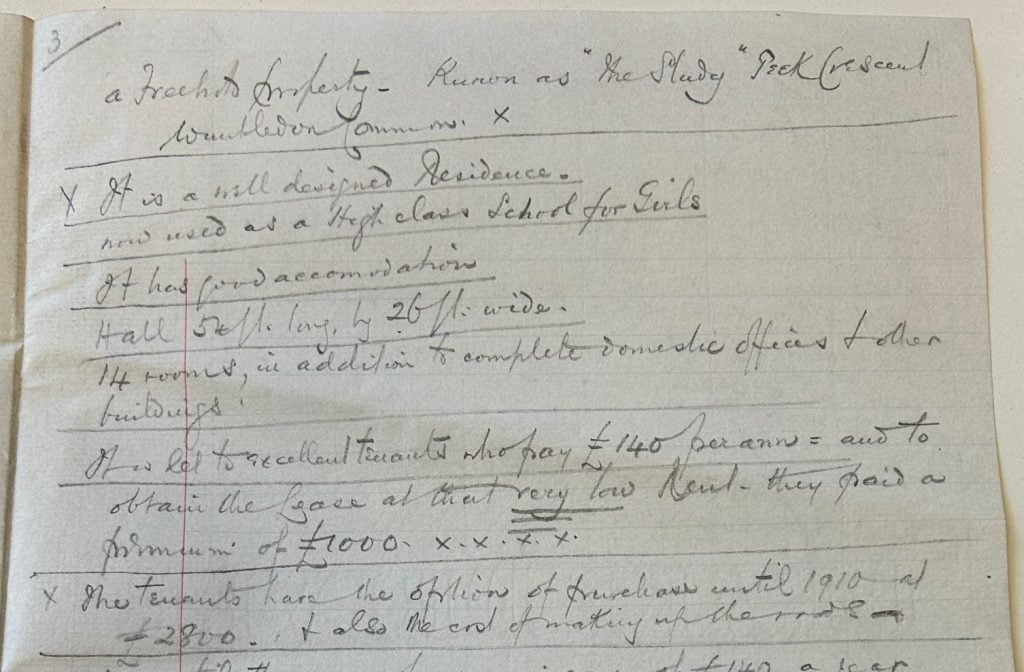
These notes also state that there are 23 properties for sale, or otherwise, in the auction.
It is therefore reasonable, but not certain, to link this to the undated post auction report and computations that also indicate that 23 properties were at that auction.
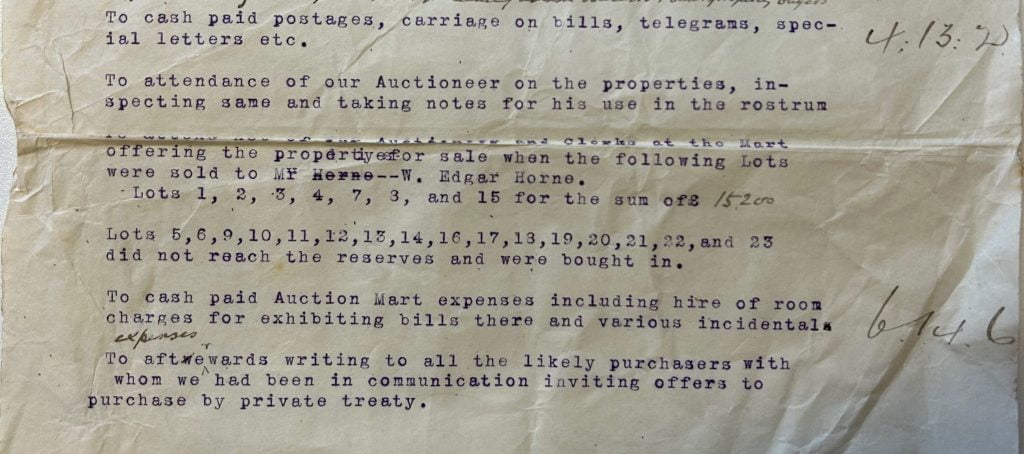
The yield of this auction from the notation on the second page of the post auction report appears to be £15,200. Again not exactly spectacular when the outlay on purchasing the Estate was of the order of £160,000 plus any further outlays on roads and general organisation.
Third auction – undated
We have a beautifully written out version of “Particulars of properties to be submitted for sale” sadly this is undated but we can infer that this auction occurred after 1906 as it mentions auctioning properties that had leases commenced in 1906. We would infer from the leases starting in 1906 and generally being for three years on the Wimbledon House Estate that the auction was probably in 1909 but this is pure conjecture.
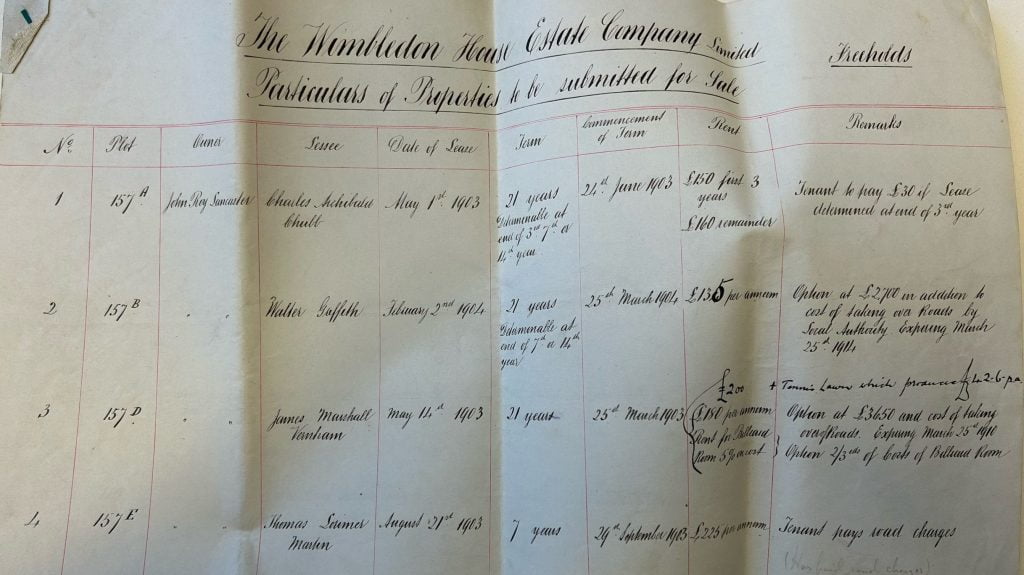
Correspondence hinting at a slow down in interest and activity – January 1912
There is a lump of correspondence prior to the February 1912 auction that hints at a soft property market, an attempt to extract one purchaser from their contract to purchase which seems to be a regular feature of proceedings, and some low ball offers, for a site ‘ Newlands’ on Calonne Road and for land between The Old Lodge and Falconhurst, for in a rather obvious attempt to snap up properties prior to the auction.
Fourth Auction – February 1912
Fortuitously the full particulars and results of the 1912 auction survive, albeit scattering in various holdings which we have pieced together here, including what are probably the auctioneers notes.
Starting with the full and annotated auction catalogue LMA [B/BAL/01/014]
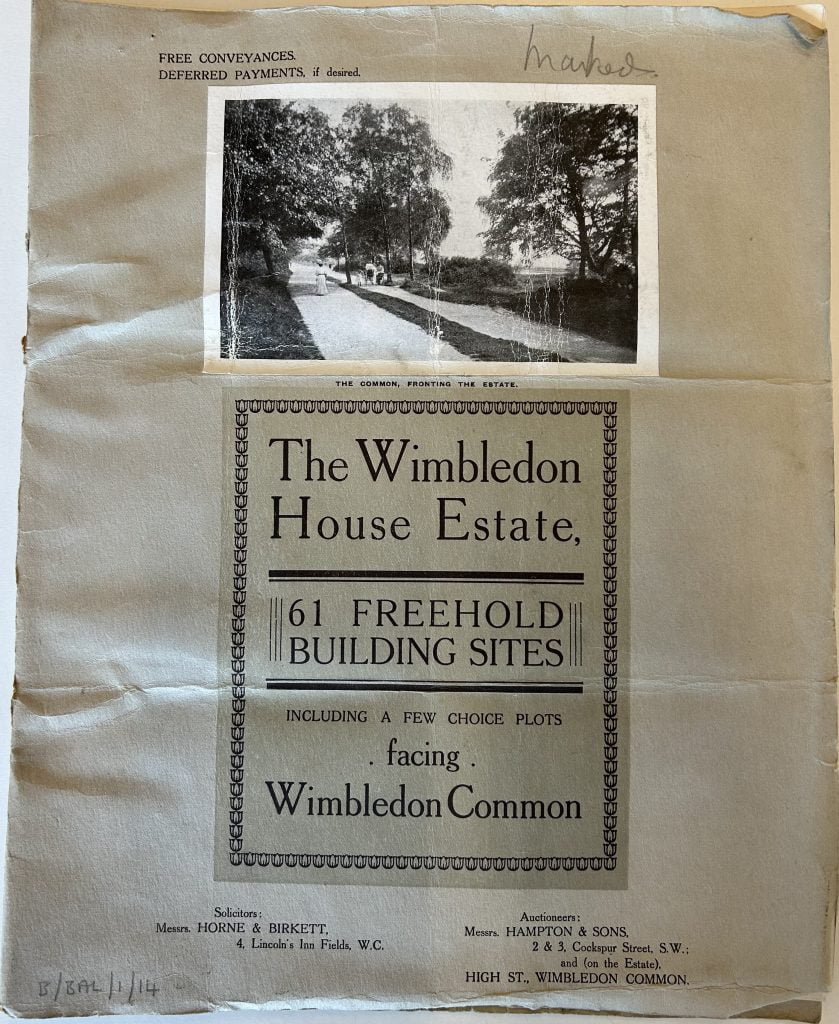
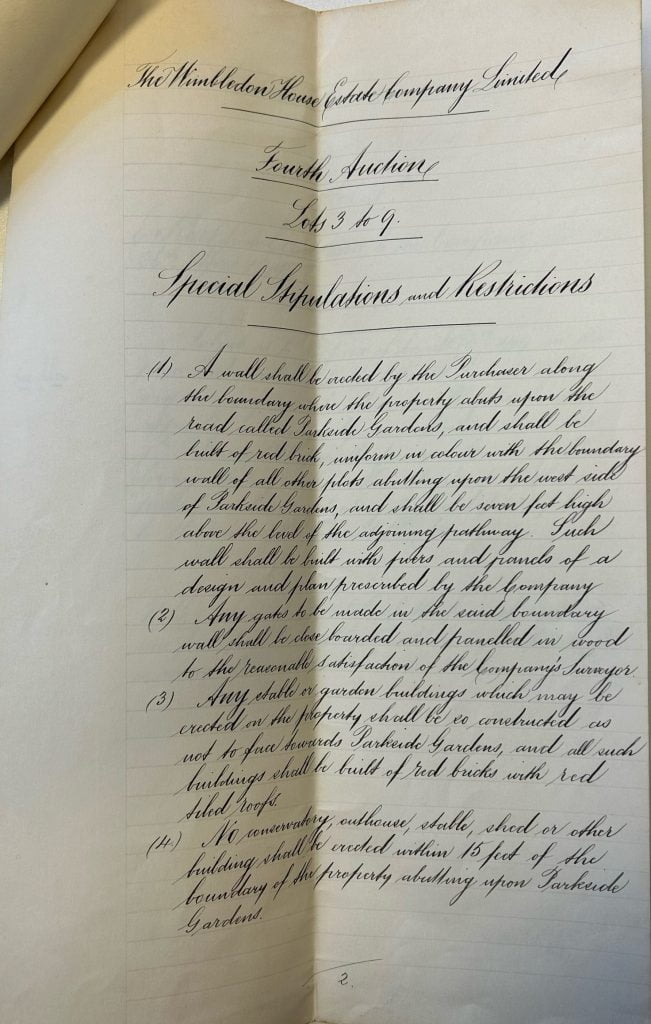
The full version of the auction catalogue that survives in the London Metropolitan Archives [B/BAL/01/014]. Interestingly, this is in a file accessioned from Balch & Balch Estate Agents and Company. A Mr Balch also wrote in connection with Lot 43 on 13th March 1912.
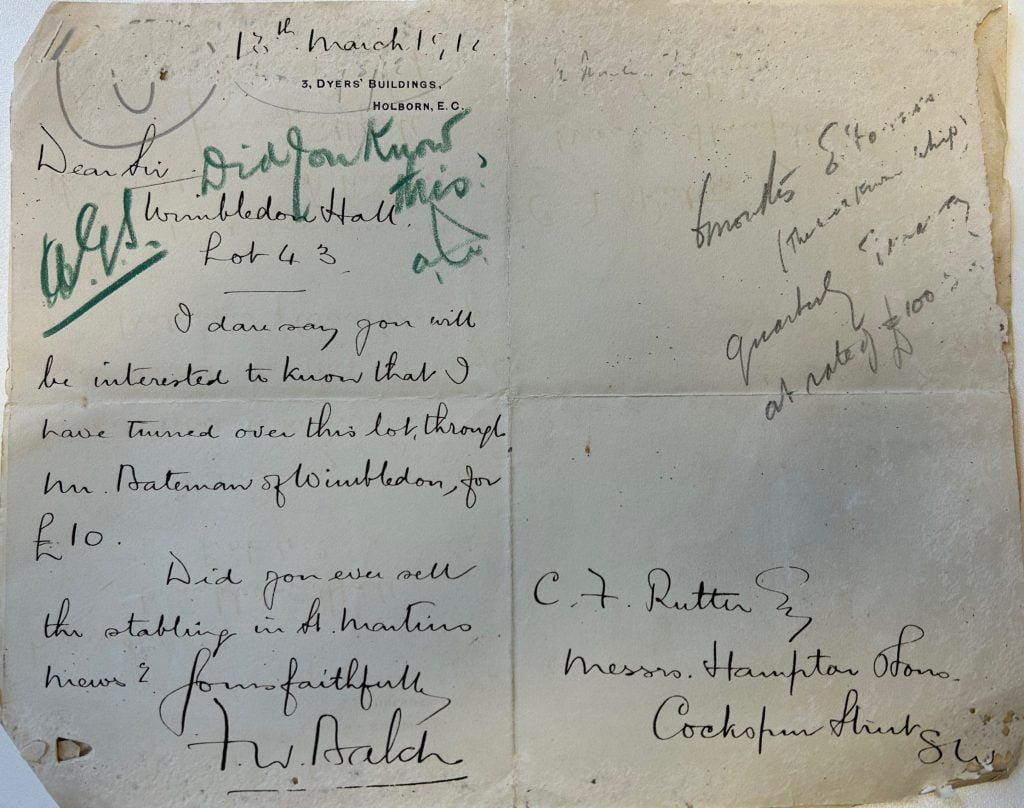
We have reproduced the 1912 Auction Catalogue’s map below by kind permission of one of our clients. Although this was not attached to the catalogue as it is in the LMA copy: the map itself is identical. As we saw from the 1906 auction printing paperwork above the maps were printed separately from the catalogues and judging by some of the letters were frequently sent out separately to interested parties, so this is perhaps not surprising.

However, the notation is not consistent so it may be best to await an analysis of the ledgers.
Just as John Augustus Beaumont found 50 years before, selling plots on a very high end estate is a very slow business. So 12 years into this venture an auction for a remarkable 61 plots was still possible.
This is, perhaps, the price that both estates paid for being so controlling on how the site was developed.
A slowing market
There is a bundle of correspondence referring to a general slow down of the market and a slowing of the pace of sales in the Wimbledon House Estate
This goes to show that property cycles are nothing new!
WWI 1914-18
WWI then interrupts proceedings and things are very slow to pick up afterwards.
WWII 1939-45
Relatively little bomb damage was suffered during WWII.
16-18 Burghley Road were destroyed by enemy action as can be seen from the 1947 RAF aerial view below if you zoom right in.
A superb 1947 RAF aerial photo showing almost the whole of the Wimbledon House Estate and the last days of the Margin House with its lake and parklands that the residents so much enjoyed.
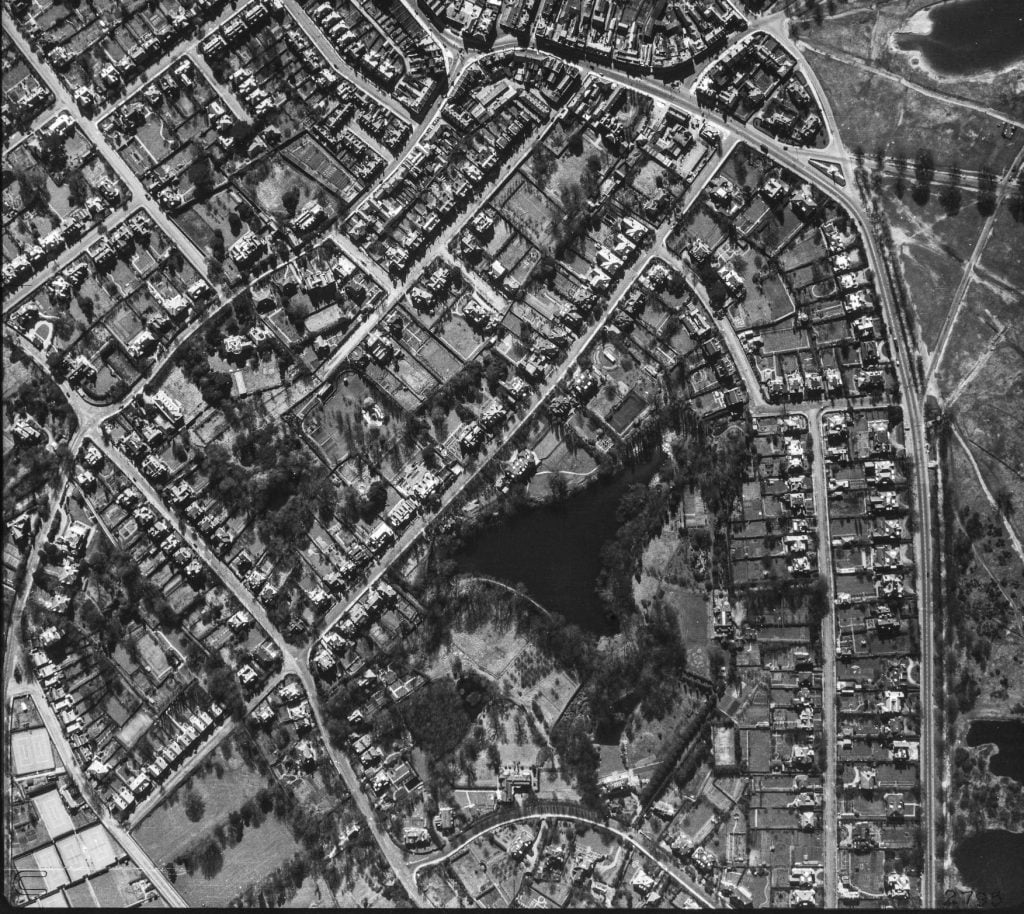
The end of Margin House and its lake
It was a fundamental part of the understanding on which plots on The Wimbledon Park Estate Company Ltd lands were purchased that there would be a magnificent recreational area with a lake in the centre of the estate.
Indeed strict covenants to that effect were set up.
The Wimbledon Guardian, in an article entitled “Heritage: Whatever happened to Wimbledon’s second lake?” 25th April 2014 states:-
“By 1953 all three [sic mansions on the site] were empty and local builder M. Howard of Mitcham bought the entire 16 acres for development. His plan was to provide new housing by dividing the mansions into smaller dwellings and building more than 40 low-rise houses. The lake would be drained.
He faced three obstacles. Covenants dating from 1899 restricted development, there was major local opposition in defence of the lake, and the drainage was a technical challenge.
When he applied to the Lands Tribunal for the covenants to be varied, there were no fewer than 87 objectors at the 1954 hearing. However, after several days, agreements were reached in all but three cases.
The judge gave weight to the fact that the three mansions [sic on the site] were un-saleable and un-lettable in their deteriorating condition.
But, much more significantly, he [sic the judge] also said the lake was in a dangerous state through erosion and seepage and likely to be permanently emptied for safety reasons.
The covenants were modified but stringent conditions were imposed on design, retention of trees and construction works.
The work began but the task of draining the lake nearly bankrupted the firm. Bricks being in short supply, modest houses with generous gardens were built on plots laid out on the extended Parkside Avenue and new roads named Margin Drive, Windy Ridge Close and Deepdale were created.”
Margin House was registered to M. Howard (Mitcham) on 7th May 1954 from an entry in the London Gazette [1954 p2699].
Amazingly we have the price list for the sale of the properties on the Margin House development from M. Howard (Mitcham) Ltd. This must date from the late 1950’s to early 1960’s as it took quite some time to drain and fill the lake.

‘Barrogill’ to a Temple
One small section of the Wimbledon House lakes has survived – in what are now the grounds of the Buddhapadipa Temple. The ponds off, what became Calonne Road, used to receive a cascade of water from the upper lake in the days of the old Wimbledon House.
For some 50 years from the 1920s, these lower lakes lay within the grounds of a large house called Barrogill.
In the early 1970’s Barrogill was bought by the London Buddhist Temple Foundation with support from the Thai Government and a Thai style building was erected in the grounds for monastic ceremonies.
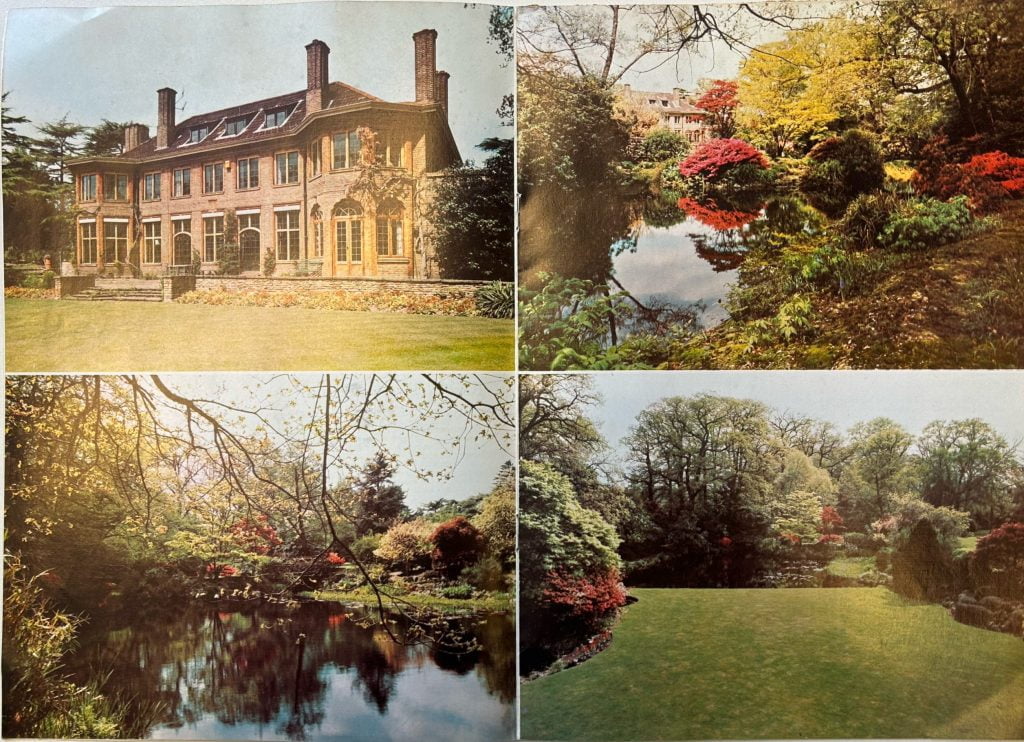
You can see the full 1970’s brochure here.
The temple now overlooks the ponds – all that remains of Wimbledon’s second lake.
Aerial Photography
1938 you can see the Hamptons office and Margin House
https://historicengland.org.uk/images-books/archive/collections/aerial-photos/record/EPW057028
1924
https://historicengland.org.uk/images-books/archive/collections/aerial-photos/record/EPW011658
1926 bottom of Marryat road facing AELTC
https://historicengland.org.uk/images-books/archive/collections/aerial-photos/record/EPW016646
1938 you can see Hamptons office and the common
https://historicengland.org.uk/images-books/archive/collections/aerial-photos/record/EPW057214
1938 you can see the Hamptons office and Margin House
https://historicengland.org.uk/images-books/archive/collections/aerial-photos/record/EPW057028
1937 Burghley and Calonne Roads
https://historicengland.org.uk/images-books/archive/collections/aerial-photos/record/EPW056172
1937 Bottom of Marryat road and Burghley road
https://historicengland.org.uk/images-books/archive/collections/aerial-photos/record/EPW053654
1923 junction of Calonne before houses were built – damaged negative
https://historicengland.org.uk/images-books/archive/collections/aerial-photos/record/EPW008873
https://historicengland.org.uk/images-books/archive/collections/aerial-photos/record/EPW008525
Wimbledon House Estate today
The Wimbledon House Estate of today is still one of the most desirable places to live in in South West London. With its large houses on substantial plots they lend themselves to being substantially developed with basement conversions, often including a basement swimming pool, and large add on extensions. The estate has fortunately not suffered so much from knock-down-and-rebuild as other areas of Wimbledon: have thus preserving its inherent character and charm
¹In a Transcription of the Slave Compensation Account and Litigated Slave Compensation Account – Mike Anson & Michael D. Bennett (2022), ‘The collection of slavery compensation, 1835-43’, Bank of England Staff Working Paper no. 1,006, Bank of England
Their appearance in the register does not, of itself mean they were slave owners. Many of the persons and entities listed were agents for processing the payments and bonds from the scheme(s)
| Charles | Marryat | 10 transactions | £1,384 |
| Joseph | Marryat & Charles Marryat | 2 transactions | £49 |
| Charles | Marryat & Charles William Short | 1 transaction | £250 |
In the litigated part of the scheme
| Joseph | Marryatt | 1 transaction | £23 |
| Joseph | Marryatt & Charles Marryatt & Charles William Short | 1 transaction | £94 |



